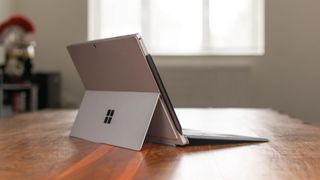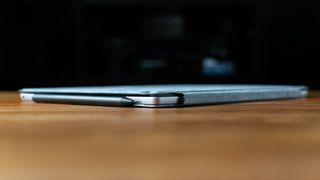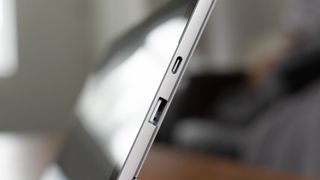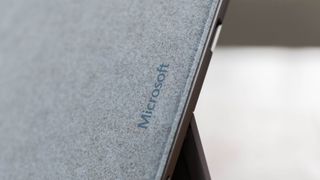IT Pro Verdict
Pros
- +
Outstanding display
- +
Improved performance
- +
Removable SSD
Cons
- -
Poor battery life
- -
Limited SSD replacement options
- -
Expensive












It seems that, much like climate change, remote working, and Love Island, mid-generation device upgrades are something that we’re just going to have to get used to. The smartphone industry has spent the past several years releasing slightly newer iterations of its devices with minor improvements in between its main flagships, and Microsoft is joining in now, too.
The Surface Pro 7+ is very much the equivalent of an s-model iPhone, aimed at providing a slightly better experience without needing all the bells and whistles of a full generational update. These improvements mainly take the form of a newer and more powerful processor, a removable SSD, and support for 4G connectivity - all of which will be most attractive to enterprise customers. Fittingly, it’s a business-only device, but just because it’s aimed at businesses doesn’t necessarily mean they’ll actually be clamouring to get their hands on it.
Microsoft Surface Pro 7+ review: Design
It uses an almost identical chassis as the original Surface Pro 7. That means the device is the same thickness (8.5mm) and six grams lighter (784g vs 790g) for the Core i7 model on test here (not including the TypeCover keyboard). It’s also got the same ports - the only real difference is the hatch providing access to the SSD, which we’ll discuss in greater detail below.
Unsurprisingly, it’s as visually appealing as we’ve come to expect from the Surface range, which remain some of the most attractive Windows devices on the market. Just like its predecessors, the Surface Pro 7+ is effortlessly functional in its design and elegant without needing flashy design flourishes.
Microsoft Surface Pro 7+ review: Display
Display quality has become another hallmark of the Surface range, and the 7+ does nothing to tarnish that legacy. It mimics the Pro 7 in this arena as well; its 12.3in panel features the same 2736 x 1824 resolution and racked up an identical 92% coverage rating of the sRGB colour gamut in our tests.

This score, combined with an outstanding Delta E rating of 1.1 and a measured contrast ratio of 1405:1, indicates that this panel is superbly accurate, making it ideally suited to colour-sensitive design and creative work. It’s a sterling display all over, rounded out by a luminous maximum brightness of 412cd/m2.
Microsoft Surface Pro 7+ review: TypeCover keyboard
By now, you’re probably sensing a pattern emerging here; the Surface Pro 7+ uses the same TypeCover keyboard as its predecessor, and really there isn’t much more to say. It’s still one of our favourite laptop typing experiences, with crisp action and a responsive, satisfying trackpad, as well as a plush Alcantara covering.
Its positive qualities remain unchanged, but sadly so do its flaws, with the biggest one being the fact that Microsoft continues to charge an additional £150 for the TypeCover. It’s an intrinsic part of the Surface Pro’s appeal, and selling it separately still feels like an unnecessary bit of gouging.
Microsoft Surface Pro 7+ review: Specs and performance
So far, so Surface Pro 7, but where the real changes have been made is under the hood (or in this case, kickstand). The 7+ has now been updated to run on Intel’s latest 11th-gen Tiger Lake processors, stepping up from the 10th-gen Ice Lake chips used in the previous model. It’s available in Core i3, i5 and i7 flavours, and with a maximum of 16GB of RAM - on test is the top-end variant, with a quad-core i7-1165G7 and the full 16GB RAM allocation.
The 7+ offers more than 2x faster performance compared to the Surface Pro 7, according to Microsoft. However, it didn’t quite live up to these promises in our benchmark tests. It managed an overall score of 91, which is an improvement of around a third compared to the earlier model and puts it about on par with the XPS 13 that Dell released in early 2020.

Looking at the individual test results was a little more revealing; in the image editing test, it soared ahead with a score of 135, while it lagged behind in the video and multi-tasking tests. This indicates that while this machine will perform capably enough when asked to handle strenuous multi-tasking or when running multi-threaded apps, where it really shines is single-core processing.
That’s a little disappointing. While strong single-threaded performance at the expense of multi-tasking may potentially be acceptable in a workstation, the Surface Pro is aimed at general-purpose users who will likely be bouncing between a number of different tasks and applications. Another point to note is that the rear of this device gets distinctly toasty when under load, and we measured CPU temperatures of around 50 degrees when running at full pelt. Fan noise is also noticeable, although not as disruptively loud as on some machines.
Still, the performance on show here isn’t bad, and you certainly won’t struggle with anything in a day-to-day context. It even handled video editing well. You’re also not likely to find better speeds in this form factor - at least, not until someone builds a Ryzen-powered equivalent.
Storage, meanwhile, is a notable feature. Not for the speed of the SSD itself, which is a rather middling affair - in the AS SSD benchmark, it notched up sequential read and write speeds of 1,849 MB/sec and 631 MB/sec respectively - but for the fact that the drive can now be accessed without sending the whole kit and caboodle back to base.
There’s a small hatch on the rear of the unit that can be popped open to reveal an M.2 2230 SSD which can be freely removed. Microsoft is at great pains to point out that the drive should only be removed by “a skilled technician following Microsoft instructions”, but it’s an extremely simple procedure that’s no more complicated than replacing the SSD in a standard desktop. All you’ll need is a 3IP Torx-Plus screwdriver, and you’re good to go.

Microsoft seems to be under the impression that the main reason to do this is to ensure that any data on it remains secure if the device needs to be serviced offsite, but we’re not sure we agree; replacing a failed drive or upgrading to a better model seems like it would be more applicable to most businesses. However, Microsoft doesn’t sell replacement SSD kits outside the US, and doesn’t support or validate any third-party SSDs for use in the device, so all told, this may be less useful than it initially appears.
Microsoft Surface Pro 7+ review: Battery life
Battery life is another area where Microsoft has supposedly made improvements over the Surface Pro 7, increasing the battery size from 46.5Wh to 50.4Wh and pairing that with software improvements to deliver up to 15 hours of charge.
That’s the claim, anyway. Sadly, in practise, we found that not only did the Surface Pro 7+ fail to deliver a full day’s usage before dying, but it’s also actually noticeably worse than the Surface Pro 7. In our battery tests, which involve playing a looped video in airplane mode with the screen brightness set to 170cd/m2, the Pro 7+ only lasted 6hrs 40mins. That’s 40mins short of what the Pro 7 achieved, and that’s without using the 4G connectivity that this machine sells itself on.
Real-world usage was a little better; from a full charge, the Surface Pro 7+ only lasted around six hours of moderate usage before giving up the ghost, and that number dropped to around three hours when seriously taxing the processor. The sole bright spot is the 65W fast-charging capability, which managed to restore around 50% of the device’s charge after an hour.
Microsoft Surface Pro 7+ review: Ports and features
As expected, there’s not much to mention in the way of additional features. The headline feature is the option for 4G connectivity, although it’s slightly disappointing that Microsoft didn’t push the boat out on a 5G-compatible modem, as this could have given the 7+ a greater appeal for those looking for portable productivity.

Aside from that, however, it’s largely the same as the Pro 7 - Wi-Fi 6 support, a USB-C and USB-A port, facial recognition via Windows Hello, 1.6W Dolby Atmos speakers and dual far-field microphones for videoconferencing. There’s also a microSD card slot for expanding the storage, although this is only available on the Wi-Fi version, rather than the 4G model.
It’s as robust a specification as ever, and although there’s little to set it apart from its predecessor, there’s nothing really missing either. Built-in mobile connectivity is a handy addition for those that need it, and the Surface Pro 7 + does everything it needs to.
Microsoft Surface Pro 7+ review: Verdict
Having taken stock of the changes Microsoft has made to the Surface Pro 7+, we’re really not sure why it merited launching as an entirely separate device. At its core, the only differences between this device and the Surface Pro 7 are a faster processor, a removable SSD and the option for mobile internet - none of which really feel like they’re worth all this fanfare.
The ‘improved’ chip, in particular, feels like a stumble; while it’s around a third faster than its predecessor overall, and significantly better for single-core tasks, this comes at the expense of battery life which feels like a rather grim calculus. The vanilla Surface Pro 7 didn’t exactly feel sluggish, and on balance we’d rather have the security of a bit of extra day-to-day longevity.
On paper, the Surface Pro 7+ makes for a better option than the regular model; it’s faster, with more serviceable components and greater flexibility thanks to its 4G capabilities. The poor battery life isn’t exactly ideal, but it’s almost balanced out by the speedy fast-charging. However, the Surface Pro 7 is more than a year old at this point, and there’s a good chance you can pick one up for significantly cheaper than the cost of an equivalent 7+.
In fact, at the time of writing, Microsoft’s own business storefront is selling a Surface Pro 7 bundle for more than £300 cheaper than the combined cost of a Pro 7+ and the essential TypeCover keyboard. While the newer version sports a couple of improvements, they’re not enough to make it that much more appealing than its older sibling.
Microsoft Surface Pro 7+ specifications
| Processor | Intel Core i7-1165G7 |
| RAM | 16GB |
| Graphics adapter | Intel Iris Xe graphics |
| Storage | 256GB SSD |
| Screen size (in) | 12.3in |
| Screen resolution | 2,736 x 1,824 |
| Screen type | PixelSense display |
| Touchscreen | Yes |
| Memory card slot | MicroSDXC card |
| 3.5mm audio jack | Yes |
| Graphics outputs | 1x USB-C port |
| Other ports | 1x USB port, 1x Surface Connect |
| Web Cam | 5 megapixel 1080p front-facing camera |
| Speakers | 2x 1.6W stereo speakers with Dolby Atmos |
| Wi-Fi | Wi-Fi 6 |
| Bluetooth | Bluetooth 5.0 |
| NFC | N/A |
| Dimensions, mm (WDH) | 292 x 201 x 8.5 mm |
| Weight (kg) - with keyboard where applicable | 784g |
| Battery size (Wh) | 50.4Wh |
| Operating system | Windows 10 Pro |
Adam Shepherd has been a technology journalist since 2015, covering everything from cloud storage and security, to smartphones and servers. Over the course of his career, he’s seen the spread of 5G, the growing ubiquity of wireless devices, and the start of the connected revolution. He’s also been to more trade shows and technology conferences than he cares to count.
Adam is an avid follower of the latest hardware innovations, and he is never happier than when tinkering with complex network configurations, or exploring a new Linux distro. He was also previously a co-host on the ITPro Podcast, where he was often found ranting about his love of strange gadgets, his disdain for Windows Mobile, and everything in between.
You can find Adam tweeting about enterprise technology (or more often bad jokes) @AdamShepherUK.
